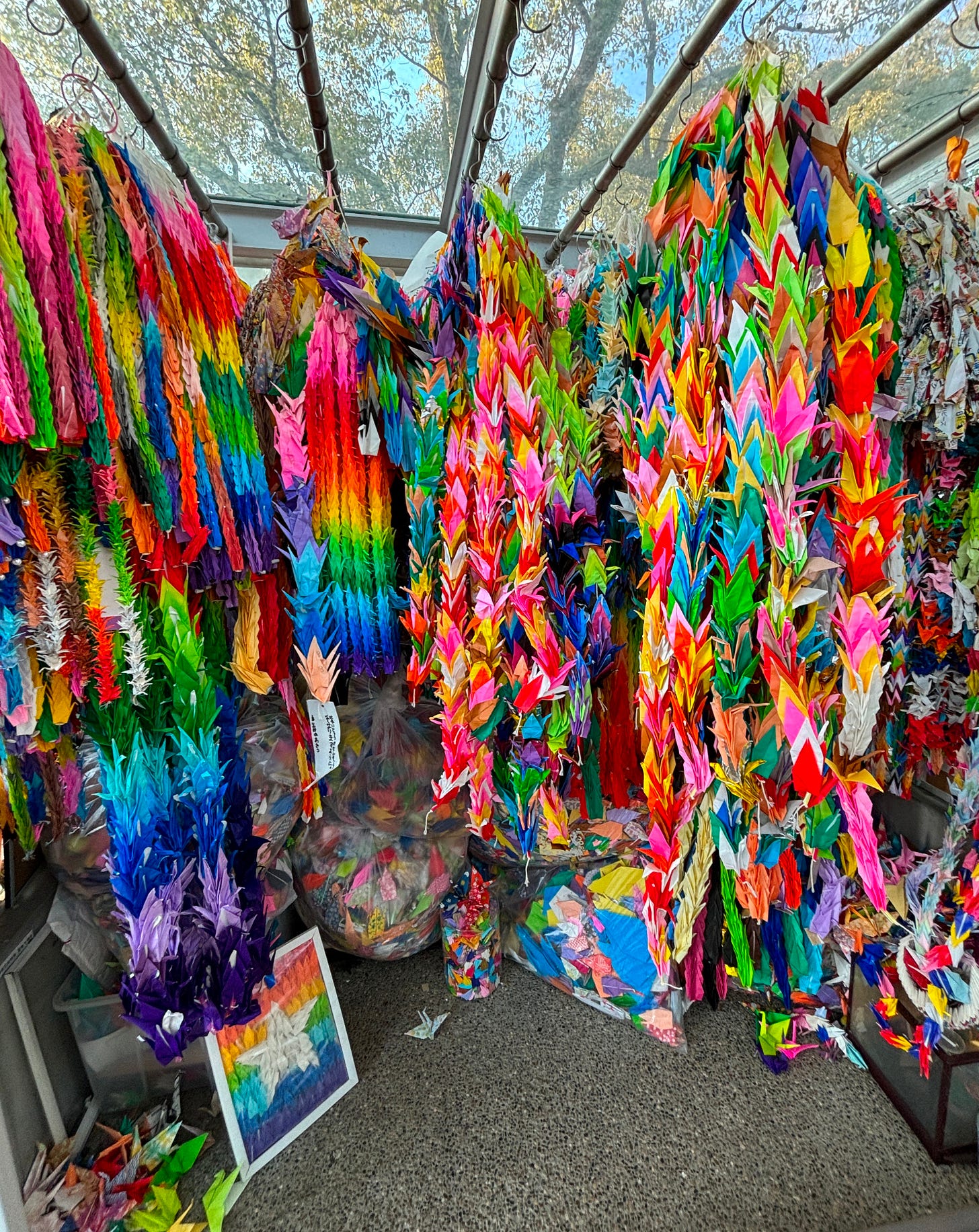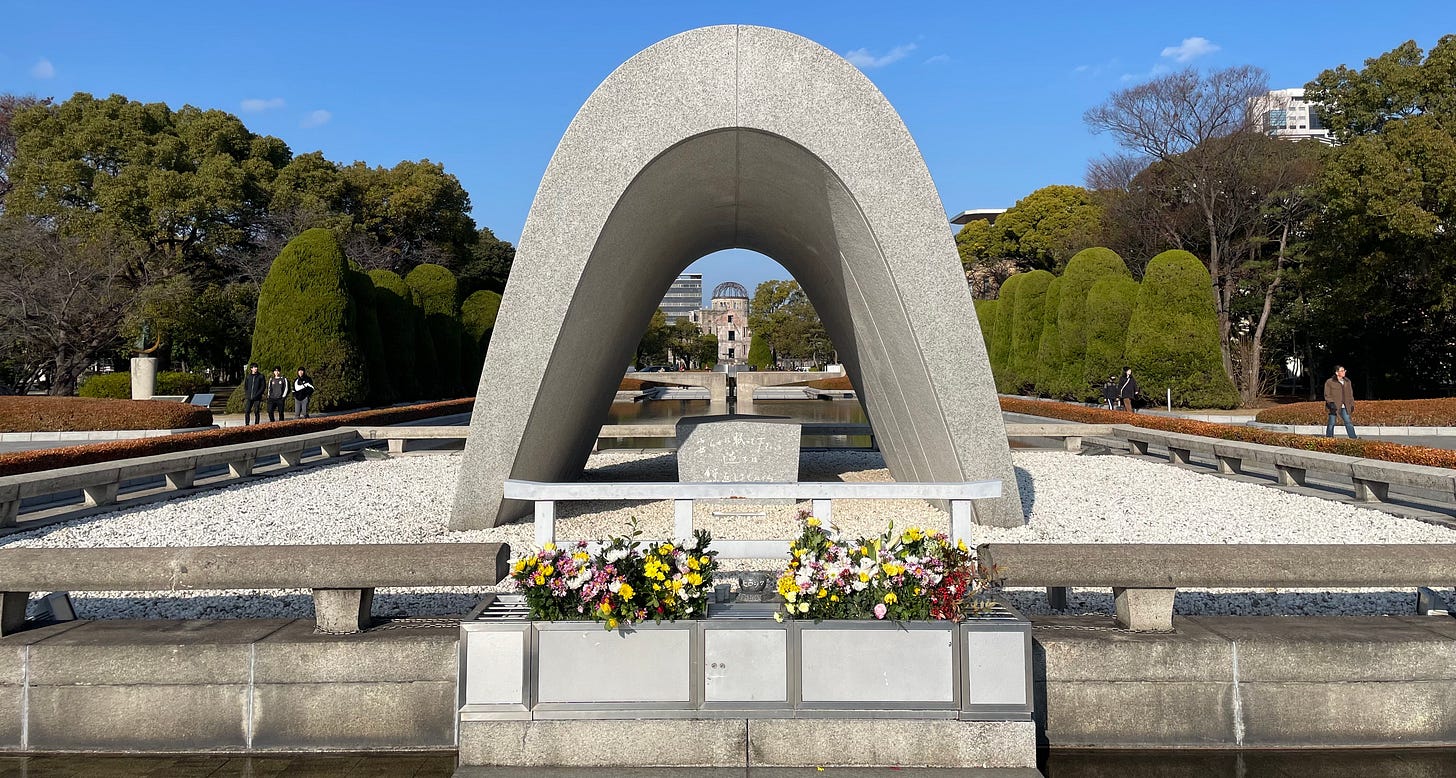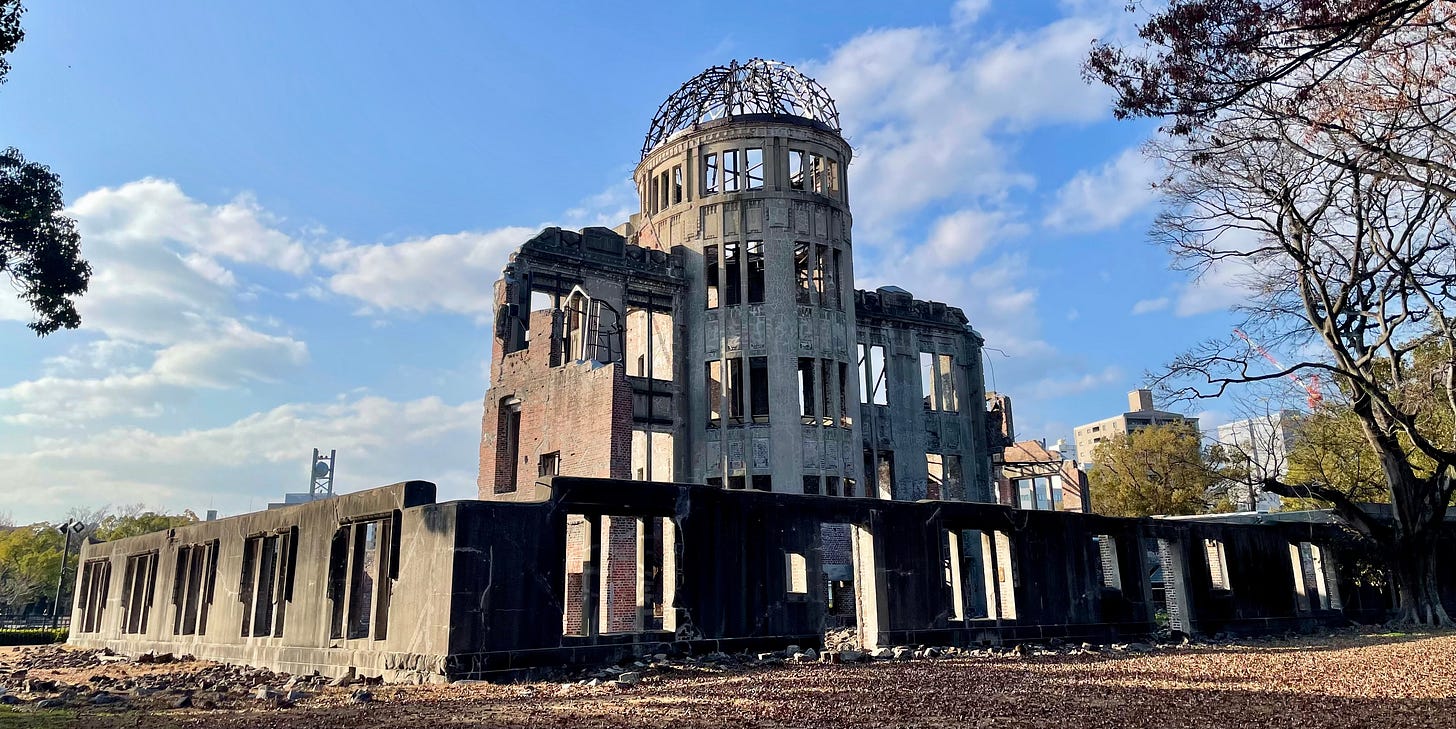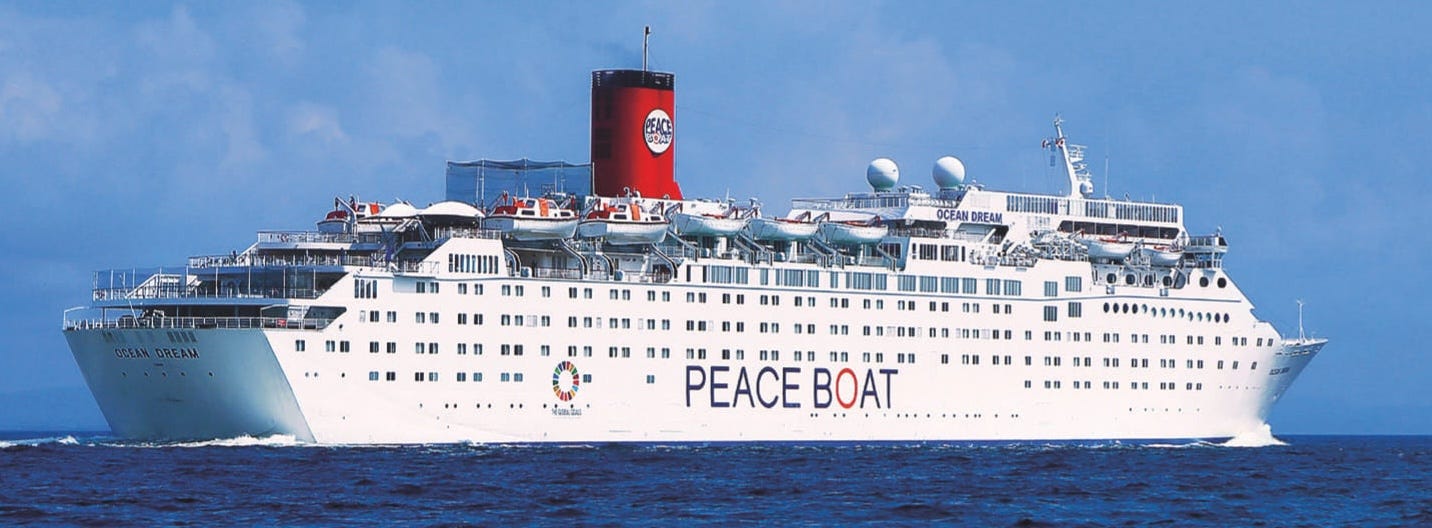The Call of Hiroshima: Then and Now
When Nihon Hidankyo was awarded the 2024 Nobel Peace Prize last week, my thoughts returned to Hiroshima—where Adrian and I walked earlier this year through streets still etched with memory. We spent several hours with Toshiko Tanaka, an atomic bomb survivor whose life has been shaped not only by the horrors she endured but by the quiet, steadfast labor of peace-building. Standing in a city once leveled by a bomb dropped by my own country, I felt the weight of a contradiction I couldn’t ignore: a nation that speaks of freedom, democracy, and human rights—yet perpetuates cycles of violence that ripple across generations.
Hiroshima felt cloaked in stillness, heavy with remembrance. And as we wandered its quiet paths, U.S. bombs were falling once again on civilians elsewhere. It was a haunting reminder that the past isn’t as far behind us as we wish it to be.
In Hiroshima’s Peace Memorial Park, encircled by thousands of paper cranes, the silence deepened, thick with the weight of remembrance. The cranes trace their origin to Sadako Sasaki, a young girl who survived the atomic blast and, with a child's unwavering hope, began folding cranes in a bid for healing. A thousand, she believed, would grant her wish to live. Sadako died before she could finish, but her classmates completed the final cranes in her honor. Today, those delicate origami cranes have become symbols of Hiroshima’s journey from ruin to renewal—each fold a quiet act of resistance, a testament to how small, steadfast gestures can take root in the collective heart and turn memory into resolute action.
Now, these fragile origami figures embody Hiroshima’s passage from ruin to renewal, each fold a testament to how small, persistent gestures can root themselves in the collective heart, transforming memory into quiet but resolute action.

Hiroshima stands not only as a testament to resilience but as a blueprint for peace—a call to rebuild, piece by piece, through justice, accountability, and compassion. Toshiko Tanaka’s life embodies this ethos. Her quiet strength urges us to bear witness—to suffering, to survival, to the stories that must not be forgotten—and to hold power to account.
This path demands courage: the courage to resist complacency, to question entrenched systems, and to amplify voices too often ignored. It asks us to look unflinchingly at the suffering civilians—and especially children—still endure, and to let that truth move us to act.
Through Toshiko’s Eyes: Memory, Silence, and Survival
Over Hiroshima’s signature dish of okonomiyaki, Toshiko Tanaka shared her story, her voice steady but weighted by memory. On August 6, 1945, just shy of her seventh birthday, she was on her way to school, only two kilometers from Ground Zero. As the American B-29 roared overhead, she looked up—and in an instant, the sky flared into a blinding light. A wave of heat scorched her skin. She raised her arm to shield her eyes, sparing her sight but leaving her arm, neck, and head seared by the blast.
As she staggered home, Toshiko passed neighbors whose skin hung in ribbons, children who collapsed mid-step. The scene, she later recounted, was like watching tomatoes plunged into boiling water, their skins slipping away effortlessly. The image lodged itself in my chest—a tightening ache that spread through my ribs. It wasn’t just for the children of Hiroshima, but for those on my screen—small bodies pulled from rubble, limbs dusted in ash, trembling with fear. Their suffering clings to the air, seeping into my bones like a damp, inescapable cold—a reminder that no distance shields us from the shared grief of shattered lives.
When Toshiko regained consciousness after drifting in and out for days, the sky hung thick with 'terrible smoke.' It billowed from schoolyards and parks where bodies—too many to bury—had been reduced to ash in makeshift cremations. The air carried a profound, clinging loss, a grim reminder of the nearly 200,000 lives erased in Hiroshima and Nagasaki before the year’s end.
As we sat in Toshiko’s home, the comforting aroma of tea and sizzling okonomiyaki wrapped around us, cocooning us momentarily from the weight of her memories. The warmth of the meal, her kindness, and the intimacy of her storytelling created a sharp contrast—moments of quiet human connection set against the backdrop of tales of unfathomable suffering. That dissonance has stayed with me, a reminder that peace, though it can be found in the small rituals of care and hospitality, is delicate—fragile, always at risk of slipping through our fingers.

Later, as we walked through Peace Memorial Park, we felt the same quiet Toshiko had described—a silence heavy with memory and loss. The monuments stood like quiet sentinels, their presence solemn and immovable, bearing witness to lives stolen and histories that demand to be remembered. Standing among them, I felt the enormity of human suffering press inward. It stirred the same questions I’ve wrestled with before: How do we make sense of the depths of cruelty we are capable of? And how, in the face of so much darkness, do we find the strength to keep moving forward?
I’ve walked the grounds of Dachau and Auschwitz, Cambodia’s Killing Fields, explored the War Remnants Museum in Vietnam, and the Apartheid Museum in South Africa, and investigated genocide and war crimes in Rwanda and Bosnia —each place a chapter in humanity’s capacity for violence. Yet Hiroshima unearthed something deeper, a truth we resist: memory alone cannot dismantle cycles of violence. Each of these places, seared by atrocity, calls us not only to remember but to act—to refuse indifference in the face of suffering that persists, visible and unyielding, across generations.

Today, as atrocities unfold before our eyes, broadcast in near real-time, the lessons of history demand more than reverence. They demand responsibility—an understanding that each small, deliberate act toward justice and peace challenges the forces that keep these cycles alive. Dachau, Hiroshima, Rwanda—none are relics; they are calls to conscience, urging us toward the deliberate construction of a world that refuses to let the past repeat.
It became clear that Toshiko’s story was more than personal pain—it was a plea, a call to empathy, understanding, and, most urgently, action. Both Dachau and Hiroshima teach that peace is not an inheritance; it is a daily choice, one we must continue to make even when the burden of history feels unbearable.
In the months following the bombing, Toshiko recounted how survivors developed alarming symptoms: purple spots, uncontrolled bleeding, relentless nausea. At the time, no one knew these were the effects of radiation exposure—a truth the U.S. government downplayed to control the narrative. Many who initially appeared unscathed later succumbed to agonizing deaths as their bodies unraveled from radiation poisoning. Toshiko still lives with its lingering impact—painful sores, cataracts clouding her vision, and abnormal white blood cell counts, each a reminder of the invisible scars left by that day.
Toshiko shared one particularly haunting memory: her aunt, a woman in her twenties, left the house that morning and never returned—a disappearance that remains unresolved, hanging in the air like unfinished grief. This personal loss mirrors the thousands of stories from that day—families torn apart, their loved ones swallowed by chaos, never to be seen again. The bomb didn’t just steal lives; it left behind a hollow ache of unanswered questions, forcing survivors to wrestle with loss in a world that demanded they move forward without closure.
In their world shaped by such loss and unanswered questions, survivors like Toshiko have folded their lives, piece by piece, like delicate paper cranes—patiently and with intention—into pleas for peace. Her journey shows how healing begins with small, deliberate acts.
The work of peace does not erase trauma but offers a path toward healing—as seen in efforts like South Africa’s Truth and Reconciliation Commission, which laid a foundation for a fractured nation to rebuild. Whether personal or collective, peace-building allows individuals and nations to move forward, even when scars remain. Rwanda’s gacaca courts aimed to foster reconciliation after the genocide, bringing communities together through a unique approach to justice. While the country has achieved notable stability and economic growth, increasing authoritarianism raises concerns about restricted political freedoms. Sustainable peace hinges on the need for inclusive and accountable governance.
The Transformative Power of Storytelling and Peace-Building
For most of her life, Toshiko Tanaka carried the weight of Hiroshima in silence. Japanese cultural norms—especially for women—discouraged discussions of trauma, valuing quiet endurance. Survivors knew that speaking out risked societal prejudice, potentially affecting not only their lives but their children’s futures. Tanaka’s daughter Reiko—now breaking cultural norms in her own way as an executive coach—explained that Japan’s high-context culture values subtlety and non-confrontation, which kept many survivors from openly processing their pain. But after her husband’s death, Tanaka found herself drawn to the Peace Boat, where each shared memory became like a carefully folded paper crane, transforming grief into resilience. Through encounters with other conflict survivors, she came to see her story as part of a larger, global narrative of resilience and healing.
At 70, Tanaka began learning English to share her story with a wider audience. She reframed her experience not as a personal burden but as a call for empathy and understanding. Speaking of the 'chains of love and peace' she's witnessed, she believes that dialogue can break down indifference and build bridges toward reconciliation. Like each crane folded in Hiroshima, her story became a small yet powerful offering—a fragile step toward healing, inviting us to listen and respond with compassion.
Renewing Commitment Through Action and Compassion
Toshiko’s story reminds us that peace is not an abstract ideal but a deliberate choice we renew each day. Her plea to break the 'chain of hatred' urges us to reject cycles of retaliation and build bridges toward reconciliation. The cranes of Hiroshima are not just symbols; they embody a lifelong commitment to peace—an undertaking that takes shape gradually, through acts of justice, empathy, and accountability, passed through generations. It’s a reminder that peace unfolds over time, with each generation carrying the work forward, bringing us closer to a world where reconciliation becomes the norm.
In Liberia, it was not governments but ordinary women who helped end years of civil war, proving that peace-building often starts with individuals who refuse to give in to despair. These actions—and the inaction or indifference from the global community that so often surrounds them—demand more than historical reflection; they compel us to confront the harm we perpetuate today.
As I walked through Hiroshima, I felt the crushing weight of anger, grief, and unsettling truths pressing down on me. Knowing that the bombs dropped here—and in places like Gaza, Lebanon, Yemen, Iraq and beyond—bear the unmistakable mark of my country felt like a burden too heavy to carry. It is a legacy of devastation that completely overwhelms me —the painful reality that my country has repeatedly played a key role in in cycles of violence unfolding across generations.
Despite the lessons of past mistakes—from Vietnam to Iraq to Libya to the 20 year war in Afghanistan—the U.S. continues to arm and diplomatically support allies like Israel and Saudi Arabia, whose military campaigns and blockades devastate civilian populations.
These actions—and the silence that often accompanies them—demand more than historical reflection; they compel us to confront the harm we perpetuate today. Understanding history is one thing; carrying the weight of belonging to a nation complicit in such devastation is another. The sharper question is: How can healing occur without honest reflection and accountability from all parties involved—including, and especially, my own country? Our accountability cannot stop with acknowledging past mistakes; it must extend to the present, where our policies, military aid, and inaction continue to fuel widespread suffering. Whether through direct intervention or tacit support, the consequences of U.S. involvement ripple across generations, requiring us to confront our role with humility and resolve.
Justice is not just for the victims—it lays the foundation for a future free from fear. Reconciliation cannot take root without justice. Holding perpetrators accountable offers validation to victims, restores dignity, and rebuilds trust between communities. Accountability is not only a moral imperative but a practical necessity for breaking cycles of violence. Without it, unresolved grievances fester, creating the conditions for future conflict.
Hiroshima offers a powerful reminder that peace is not passive; it demands action, empathy, and accountability, pursued daily through deliberate choices. Through these efforts—both personal and collective—we create the possibility of a future where peace is not merely an aspiration but a lived reality. Just as Sadako’s cranes call us to fold peace into the fabric of our lives, each of us can take small, intentional actions—advocating for justice, amplifying the voices of the marginalized, refusing to be complacent, or listening with compassion. These choices, however small, ripple outward, shaping systems and communities, bringing us closer to a world where peace becomes the norm, not the exception.
In a twist of history, Kyoto was spared from destruction thanks to U.S. Secretary of War Henry Stimson, whose personal connection to the city—having spent his honeymoon there—altered its fate. This decision reminds us that even small, personal experiences can change the course of history.
Hiroshima’s lessons are not distant warnings—they are a blueprint for how we must engage with the world today. Just as each folded paper crane in Hiroshima reflects a wish for peace, our choices—small as they may seem—shape the future we build together.
All over the world, grassroots organizations are doing remarkable work, providing aid, documenting abuse, advocating for peace, and rebuilding communities shattered by conflict. These efforts remind us that ordinary people can make an impact. Toward the end of this piece, I will share a few of these organizations, offering concrete ways to support those working tirelessly in the world’s most vulnerable regions.
Around the globe, civilians endure suffering that reflects humanity’s repeated failure to break cycles of violence. As wars rage on, the need to choose peace over retaliation has never been more urgent. Survivors like Toshiko remind us that peace is not just an ideal—it is something we build through action, across borders and divides. Her story, like so many others, carries a simple but profound message: peace must become the norm, not the exception.
Finding Peace Within: Resilience, Illness, and the Strength to Witness
While my career in human rights and conflict resolution gave me insights into resilience, living with terminal illness has unveiled a deeper truth: peace begins from within. It radiates outward, shaping how we meet life’s deepest challenges. Strength, I’ve learned, comes not just from action, but also from the stillness required to bear witness, to hold suffering with compassion, and to nurture hope.
True peace is a shared human journey. It’s found in small, deliberate acts—offering kindness, listening with empathy, advocating for the marginalized, or choosing hope when despair beckons. These gestures, like the cranes folded in Hiroshima, weave together something larger—transforming suffering into connection.
Illness has shown me that bearing witness to pain demands patience and presence. It’s about holding space—for myself, for others, and for what is unresolved—finding meaning even in moments of deep difficulty. While we cannot evade pain, we can meet it with open hearts, knowing that our willingness to endure with compassion builds the foundation for true, lasting peace.
Honoring Survivors, Pursuing Justice: The Nobel Prize and a World Beyond Fear
The Nobel Peace Prize awarded to Nihon Hidankyo reminds us that peace is not something we can take for granted; it must be actively built. Survivors like Toshiko Tanaka transformed their grief into advocacy, showing us that peace requires resilience, empathy, and a willingness to confront the past. In a world marked by escalating war crimes and human rights abuses, their example calls us to resist despair and take action—whether by supporting civilians, providing aid, or standing up against injustice.
Upon receiving the Nobel Prize, Tomouki Mimaki, head of Nihon Hidankyo, drew a profound connection between Hiroshima’s past and the suffering of children in Gaza. His words remind us that suffering knows no borders, urging us toward a shared responsibility: to break cycles of violence through empathy, accountability, and a commitment to justice. Just as the cranes in Hiroshima embody hope, our collective actions—however modest—can add to a movement for liberation and peace.
Reflecting on the conflicts I am engaging with this year in Myanmar, the West Bank, and Afghanistan, I see how intentional efforts can create ripples of change, steering us away from destruction and fostering resilience. Hiroshima’s legacy quietly yet powerfully reminds us that peace unfolds gradually, built through acts of compassion and courage passed from one generation to the next.
Suffering is all around us—but so is the opportunity for peace. What will your contribution be today? Peace doesn’t require grand gestures; each act of compassion, no matter how small, joins something greater, guiding us toward a world where peace is the norm, not the exception. The future is shaped by choices—what step will you take today to make peace possible?
Instead of reflection questions, today I’m sharing ways you can actively support civilians impacted by conflict. Below is a list of organizations dedicated to providing relief, advocating for justice, and fostering accountability in conflict zones worldwide. Each organization offers a unique approach to advancing peace and addressing the needs of those affected.
International Rescue Committee (IRC) – https://www.rescue.org
Palestine Children's Relief Fund (PCRF) – https://www.pcrf.net
Red Cross / Red Crescent – https://www.icrc.org
The International Legal Foundation (ILF) – https://www.theilf.org/skafund
War Child – https://www.warchild.org
Medical Aid for Palestinians - https://www.map.org.uk
Human Rights Watch (HRW) – https://www.hrw.org
International Center for Transitional Justice (ICTJ) – https://www.ictj.org
Breaking the Silence – https://www.breakingthesilence.org.il
·





